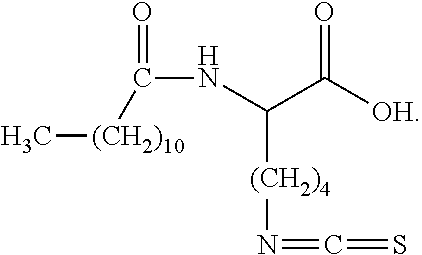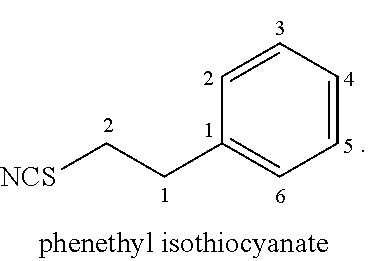Method for treating benign prostatic hyperplasia (BPH), prostatitis, and prostate cancer
a benign prostatic hyperplasia and prostatitis technology, applied in the direction of amide active ingredients, peptide/protein ingredients, aerosol delivery, etc., can solve the problems of non-desirous and/or problematic, and achieve prostatitis, and benign prostatic hyperplasia, and achieving the effect of reducing the risk of prostate cancer
- Summary
- Abstract
- Description
- Claims
- Application Information
AI Technical Summary
Benefits of technology
Problems solved by technology
Method used
Image
Examples
example i
Preparation of a mixture of Nα-lauroyl-Nε-isothiocyanato-L-Lysine with Nα,Nε-bis-lauroyl-L-lysine
[0087]A 1 liter beaker equipped with an overhead mechanical stainless steel paddle stirrer was charged with 100 mL of 1 M NaOH (0.100 mol). Stirring was begun and the beaker cooled to −5° C. to −10° C. using a salt / ice bath. Next, 23.4 g (0.100 mol) of Nε-benzylidene-L-lysine (prepared via the method of Bezas, B and Zervas, L., JACS, 83, 1961, 719-722) was added. Immediately afterward and while keeping the solution cold, 140 mL (0.140 mol) of precooled (in a salt / ice bath) 1 M NaOH and 26.1 mL of lauroyl chloride was added in two equal portions over a period of 6 minutes. The mixture was stirred for 10 more minutes at −5 to −10° C., then the ice bath was removed and the reaction mixture allowed to stir for another 1 hour while warming to room temperature. Next, the reaction mixture was cooled using a salt / ice bath and then sufficient concentrated HCl was added to adjust the pH to 7.5-7.8...
example ii
Preparation of Pure Nα-lauroyl-Nε-isothiocyanato-L-Lysine
Step 1: Preparation of Nα-lauroyl-Nε-carbobenzoxy-L-Lysine
[0088]60.0 g of Nε-cbz-L-Lysine (cbz is carbobenzoxy) purchased from Atomole Scientific Company, LTD was added to a three-liter beaker along with 1200 mL of RO water and the mixture was stirred. Next, 39 mL of 30% aqueous NaOH was added, resulting in dissolution of the Nε-cbz-L-Lysine. The resulting solution was cooled in an ice bath and then 52.5 mL of lauroyl chloride was added. The ice bath was removed 30 minutes later, and stirring continued for an additional six hours, at which time 18 mL of concentrated hydrochloric acid was added. The reaction mixture was then filtered via vacuum filtration, the white solid product washed with 1 M aqueous HCl, and then the solid product was dried in vacuo while heated to approximately 85° C. 96.5 g of dry white solid product was obtained. The product can be further purified by dissolving it in methanol, filtering off any insolubl...
PUM
| Property | Measurement | Unit |
|---|---|---|
| temperature | aaaaa | aaaaa |
| time | aaaaa | aaaaa |
| temperature | aaaaa | aaaaa |
Abstract
Description
Claims
Application Information
 Login to View More
Login to View More - R&D
- Intellectual Property
- Life Sciences
- Materials
- Tech Scout
- Unparalleled Data Quality
- Higher Quality Content
- 60% Fewer Hallucinations
Browse by: Latest US Patents, China's latest patents, Technical Efficacy Thesaurus, Application Domain, Technology Topic, Popular Technical Reports.
© 2025 PatSnap. All rights reserved.Legal|Privacy policy|Modern Slavery Act Transparency Statement|Sitemap|About US| Contact US: help@patsnap.com



